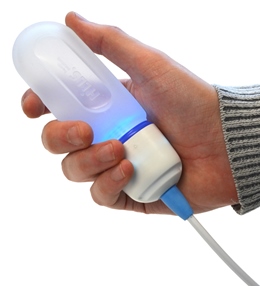19 October 2015
 UniSA designers have secured a hat-trick in the Design Institute Australia (DIA) Laminex 2015 Design Awards with a nurse’s call button designed to be used by even the most frail patients.
UniSA designers have secured a hat-trick in the Design Institute Australia (DIA) Laminex 2015 Design Awards with a nurse’s call button designed to be used by even the most frail patients.
The new device won the Gold Design Award, the President’s Award and the Premier’s Award.
Designed by a team comprising UniSA graduates Daniel Weiss and Robert White with the industrial design program director, Dr Peter Schumacher and Associate Professor Sandy Walker, through UniSA’s partnership at the Hills Industries Innovation Centre, the call button has been specifically developed for older Australians who may suffer reduced hand dexterity.
Traditional designs for the nurse’s call button have not been effective for older people with limited movement because of arthritis or low strength.
After months of research into arthritis and hand-held devices for people with arthritis, including consultation with medical specialists and an investigation of nurse call systems and how they are used, the team developed a prototype for testing.
Dr Schumacher says partnerships and project structure were a key to the success of the call button design.
“We have structured a team that allows new graduates to be supported by their lecturers to take that first step into commercial design jobs and that is proving to be a successful model,” he says.
“Through a holistic approach, which in this instance meant being able to work with an aged care provider, Eldercare, and the Hills product innovation team we have put the end-users at the centre of the project.”
Dr Schumacher says the new call button will soon be patented and is being manufactured mainly in South Australia.
“People often refer to South Australia as an ageing state, but we should be looking at that as an enormous opportunity to lead the world in innovation for ageing communities,” he says.
“Projects like this one generate jobs and there is so much potential in aged and health care to find solutions and improvements that have really broad and important applications to improve the lives of older people. This is just one success – but there is so much more potential.”
Making their comments, the DIA judges said the work was an outstanding example of how an organised design process coupled with thorough research and customer insight could lead to an innovative and successful product solution.
“To be manufactured in volume in South Australia, we believe this design will set the benchmark for well-designed aged care products,” they said.
Media contact: Michèle Nardelli office +61 883020966 mob 0418823673 email michele.nardelli@unisa.edu.au




